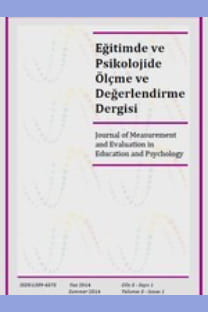Estimation and Standardization of Variance Parameters for Planning Cluster-Randomized Trials: A Short Guide for Researchers
Estimation and Standardization of Variance Parameters for Planning Cluster-Randomized Trials: A Short Guide for Researchers
___
- Bland J. M. (2004). Cluster randomized trials in the medical literature: two bibliometric surveys. BMC Medical Research Methodology, 4(21). DOI: https://doi.org/10.1186/1471-2288-4-21
- Bloom, H. S. (1995). Minimum detectable effects a simple way to report the statistical power of experimental designs. Evaluation Review, 19(5), 547-556. DOI: https://doi.org/10.1177/0193841X9501900504
- Bloom, H. S. (2006). The core analytics of randomized experiments for social research. MDRC Working Papers on Research Methodology. New York, NY: MDRC. Retrieved from DOI: https://www.mdrc.org/sites/default/files/full_533.pdf.
- Bloom, H. S., Bos, J. M., & Lee, S. W. (1999). Using cluster random assignment to measure program impacts statistical implications for the evaluation of education programs. Evaluation Review, 23(4), 445-469. DOI: https://doi.org/10.1177%2F0193841X9902300405
- Bulus, M., Dong, N., Kelcey, B., & Spybrook, J. (2019). PowerUpR: Power Analysis Tools for Multilevel Randomized Experiments. R package version 1.0.4. DOI: https://CRAN.R-project.org/package=PowerUpR
- Cameron, A. C., & Miller, d. L. (2015). A practitioner’s guide to cluster-robust inference. Journal of Human Resources, 50, 317-372. DOI: https://doi.org/10.3368/jhr.50.2.317
- Dong, N., & Maynard, R. (2013). PowerUp!: A Tool for Calculating Minimum Detectable Effect Sizes and Minimum Required Sample Sizes for Experimental and Quasi-experimental Design Studies. Journal of Research on Educational Effectiveness, 6(1), 24-67. DOI: https://doi.org/10.1080/19345747.2012.673143
- Bates, D., Maechler, M., Bolker, B., & Walker, S. (2015). Fitting linear mixed-effects models using lme4. Journal of Statistical Software, 67(1), 1-48. DOI: https://doi.org/10.18637/jss.v067.i01 Hayes, R. J. & Moulton, L. H. (2017). Cluster Randomized Trials (2nd ed.). New York, NY: Chapman and Hall/CRC Press. DOI: https://doi.org/10.4324/9781315370286
- Hedberg, E. C. (2016). Academic and behavioral design parameters for cluster randomized trials in kindergarten: an analysis of the Early Childhood Longitudinal Study 2011 Kindergarten Cohort (ECLS-K 2011). Evaluation Review, 40(4), 279-313. DOI: https://doi.org/10.1177/0193841X16655657
- Hedberg, E. C., & Hedges, L. V. (2014). Reference values of within-district intraclass correlations of academic achievement by district characteristics: Results from a meta-analysis of district- specific values. Evaluation Review, 38(6), 546-582. DOI: https://doi.org/10.1177/0193841X14554212
- Hedges, L. V., & Hedberg, E. C. (2013). Intraclass correlations and covariate outcome correlations for planning two-and three-level cluster-randomized experiments in education. Evaluation Review, 37(6), 445-489. DOI: https://doi.org/10.1177/0193841X14529126
- Hedges, L. V., & Rhoads, C. (2010). Statistical Power Analysis in Education Research (NCSER 2010-3006). Washington, DC: National Center for Special Education Research, Institute of Education Sciences, U.S. Department of Education. Retrieved from https://files.eric.ed.gov/fulltext/ED509387.pdf
- Konstantopoulos, S. (2009a). Using power tables to compute statistical power in multilevel experimental designs. Practical Assessment, Research & Evaluation, 14(10).
- Konstantopoulos, S. (2009b). Incorporating Cost in Power Analysis for Three-Level Cluster- Randomized Designs. Evaluation Review, 33(4), 335-357. DOI: https://doi.org/10.1177/0193841X09337991
- Moerbeek, M., & Safarkhani, M. (2018). The design of cluster randomized trials with random cross-classifications. Journal of Educational and Behavioral Statistics, 43(2), 159-181. DOI: https://doi.org/10.3102/1076998617730303
- Raudenbush, S. W., & Bryk, A. S. (2002). Hierarchical Linear Models: Applications and Data Analysis Methods (2nd ed.). Thousand Oaks, CA: Sage Publications.
- R Core Team (2019). R: A language and environment for statistical computing. R Foundation for Statistical Computing [Computer software]. Vienna, Austria. Retrieved from https://www.R-project.org.
- Spybrook, J., Shi, R., & Kelcey, B. (2016). Progress in the past decade: an examination of the precision of cluster randomized trials funded by the U.S. Institute of Education Sciences. International Journal of Research & Method in Education, 39(3), 255-267. DOI: https://doi.org/10.1080/1743727X.2016.1150454
- Spybrook, J., Westine, C. D., & Taylor, J. A. (2016). Design parameters for impact research in science education: A multistate analysis. AERA Open, 2(1). DOI: https://doi.org/10.1177/2332858415625975
- Westine, C. D. (2016). Finding Efficiency in the Design of Large Multisite Evaluations: Estimating Variances for Science Achievement Studies. American Journal of Evaluation, 37(3), 311-325. DOI: https://doi.org/10.1177/1098214015624014
- Westine, C. D., Spybrook, J., & Taylor, J. A. (2013). An empirical investigation of variance design parameters for planning cluster-randomized trials of science achievement. Evaluation Review, 37(6), 490-519. DOI: https://doi.org/10.1177/0193841X14531584
- Zopluoglu, C. (2012). A cross-national comparison of intra-class correlation coefficient in educational achievement outcomes. Eğitimde ve Psikolojide Ölçme ve Değerlendirme Dergisi, 3(1), 242- 278.
- ISSN: 1309-6575
- Yayın Aralığı: 4
- Başlangıç: 2010
- Yayıncı: Selahattin GELBAL
The Effect of Item Weighting on Reliability and Validity
Nuri DOĞAN, Abdullah Faruk KILIÇ
Gökhan AKSU, Cem Oktay GÜZELLER, Mehmet Taha ESER
Derya ATALAN ERGİN, Emine Gül KAPÇI
İbrahim UYSAL, Levent ERTUNA, Hülya KELECİOĞLU, F. Güneş ERTAŞ
Derya ATALAN ERGİN, Emine Gül KAPÇI
Sakine GÖÇER ŞAHİN, Metin BULUŞ
Metin BULUŞ, Sakine GÖÇER ŞAHİN
Abdullah Faruk KILIÇ, Nuri DOĞAN
İbrahim UYSAL, Levent ERTUNA, F. Güneş ERTAŞ, Hülya KELECİOĞLU
